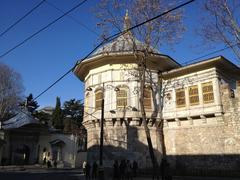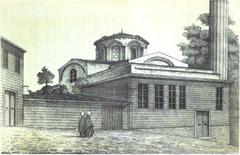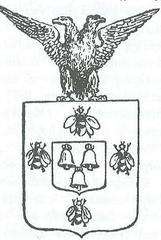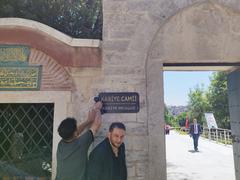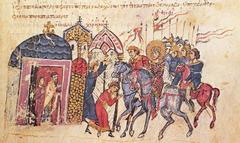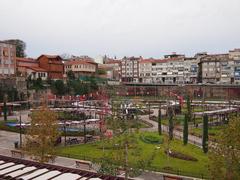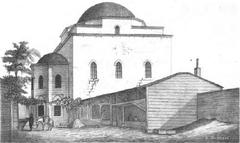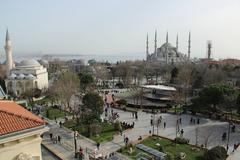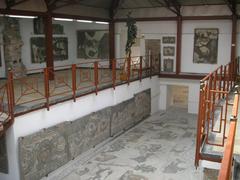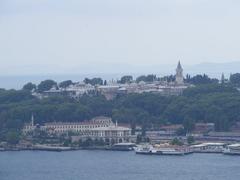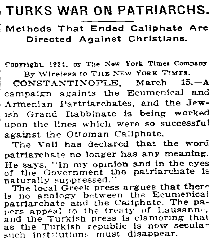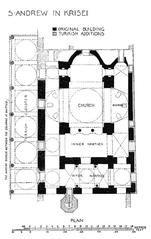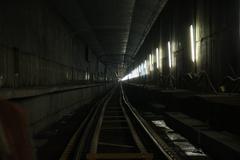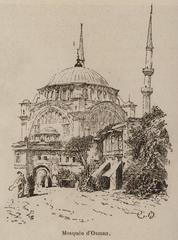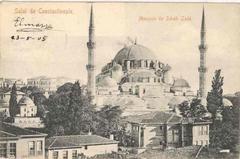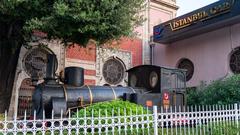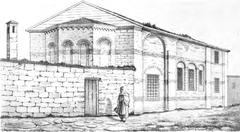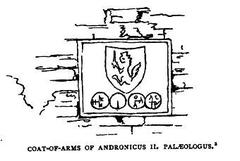
Kumkapı Railway Station Visiting Hours, Tickets, and Fatih Historical Sites Guide
Date: 03/07/2025
Introduction
Kumkapı Railway Station, located within Istanbul’s historic Fatih district, is a living testament to the city’s evolving railway heritage and multicultural urban character. Originally opened in 1872 as part of the Oriental Railway, the station played a pivotal role in linking Istanbul with European cities, serving both passengers and freight during the late Ottoman era. Its proximity to the Sea of Marmara and the vibrant Kumkapı neighborhood—renowned for its Armenian, Greek, and Jewish communities—underscored its importance in transportation, cultural exchange, and local commerce, particularly in the bustling fish market and seafood meyhanes (Istanbul Rail History; Kumkapı Fish Market).
As Istanbul modernized, Kumkapı Railway Station underwent architectural and operational changes, reflecting the city’s transition from empire to republic. Though closed to passenger service in 2013 due to the Marmaray project, the station was revitalized and reopened in 2024 as part of the T6 Tramway and U3 Rail lines, reaffirming its relevance in the city’s contemporary transit network (Marmaray Project; Kultur Envanteri).
Today, Kumkapı Railway Station offers more than transport—it is a gateway to the historic peninsula, celebrated for its seafood, multicultural heritage, and close proximity to landmarks like Sultanahmet Square and the Grand Bazaar. This guide provides comprehensive details on visiting hours, ticketing, accessibility, nearby attractions, and practical tips for an enriching experience in one of Istanbul’s most storied neighborhoods (VisitTurkey.in; Nomadic Niko).
Table of Contents
- Historical Overview
- Visiting Kumkapı Railway Station Today
- Urban Context and Cultural Significance
- Visitor Experience and Services
- FAQ
- Conclusion
- Further Resources
Historical Overview
Origins and Early Development
Kumkapı Railway Station was inaugurated in 1872 as part of the Oriental Railway, connecting Istanbul with Vienna and other European capitals. Its strategic location in Fatih made it a critical urban stop, facilitating both commercial and passenger movement (Istanbul Rail History).
Ottoman and Republican Eras
In the late Ottoman period, Kumkapı was essential for transporting goods and passengers, especially supporting the local seafood trade (Kumkapı Fish Market). After 1923, under Turkish State Railways, it became an important suburban rail link, connecting European and Asian parts of Istanbul.
Architectural Evolution
Initially featuring a blend of Ottoman and European architecture—arched windows, decorative brickwork, and a tiled roof—the station underwent modernization in the 20th century. Renovations balanced modern commuter needs with its historic character (Kultur Envanteri).
Closure and Revival
Passenger services ceased in 2013 due to the Marmaray rail realignment (Marmaray Project). However, in 2024, Kumkapı Station was revived as part of the T6 Tramway and U3 Rail lines, integrating it into Istanbul’s updated public transport system (Wikipedia).
Urban Significance
Kumkapı Station has long symbolized Istanbul’s cosmopolitanism, serving a diverse population and fostering economic and cultural exchange. Its survival and adaptation highlight the city’s ongoing efforts to balance heritage with modern infrastructure (VisitTurkey.in).
Visiting Kumkapı Railway Station Today
Hours and Ticketing
- Operating Hours: Daily from 06:00 to 23:00, aligned with citywide public transport schedules. Extended hours may apply on weekends (Wander-Lush).
- Ticketing: Electronic ticketing machines are available at the station. The Istanbulkart—valid across metro, tram, bus, and ferry lines—is the recommended payment method (istanbul.tips).
- Ticket Prices: Fares are standardized across city transport, with discounts for students and seniors.
Accessibility
The revitalized station features:
- Barrier-free access for wheelchairs and strollers
- Elevators and ramps
- Bilingual signage (Turkish/English)
- Assistance for travelers with limited mobility
Some adjacent streets may be narrow or uneven, so plan accordingly.
Travel Tips
- Best Times: Visit in the early evening for lively atmosphere, especially during warmer months.
- Dress: Modest attire is advisable for visiting nearby religious sites.
- Safety: The area is generally safe; as with any busy city, keep belongings secure and confirm prices before dining (Nomadic Niko).
- Weather: Late spring to early autumn offers the best conditions for walking and outdoor dining (VisitTurkey.in).
Nearby Attractions
- Kumkapı Fish Market: A renowned spot for fresh seafood and vibrant local life (Kumkapı Fish Market).
- Sea of Marmara Coastline: Scenic views, ideal for photography.
- Armenian Patriarchate and Churches: Reflecting the area’s rich multicultural heritage (Istanbeautiful).
- Proximity to Sultanahmet: Quick tram or taxi access to the Blue Mosque, Hagia Sophia, and the Grand Bazaar (Istanbul Investments).
- Kumkapı Meyhanes: Enjoy lively evenings with traditional Turkish and Greek music (Nomadic Niko).
Urban Context and Cultural Significance
Multicultural Heritage
Kumkapı’s history as a melting pot for Armenians, Greeks, Jews, and Turks is evident in its architecture, religious sites, and culinary traditions (VisitTurkey.in).
Culinary Scene
The district is famed for its seafood restaurants, meyhanes, and vibrant open-air dining culture—especially along Kumkapı Square.
Urban Regeneration and Sustainability
Ongoing city initiatives aim to preserve Kumkapı’s unique character while upgrading infrastructure. The integration of smart city technologies and expanded public transport supports both heritage conservation and sustainable urban development (planbleu.org).
Visitor Experience and Services
Amenities
- Modern station facilities, including waiting areas and security
- Nearby cafes, restaurants, and shops
- Accommodation options in Fatih, from budget to boutique hotels (expatguideturkey.com)
Events and Tours
- Regular cultural festivals and food events in Kumkapı
- Guided walking and culinary tours available through local operators
Frequently Asked Questions (FAQ)
Q: What are the station’s operating hours?
A: Daily from 06:00 to 23:00, with possible extended hours on weekends.
Q: How do I buy tickets?
A: Tickets are available from machines at the station; Istanbulkart is accepted across all public transport.
Q: Is the station accessible?
A: Yes, with ramps, elevators, and assistance services.
Q: What can I visit nearby?
A: Kumkapı Fish Market, Armenian Patriarchate, Sultanahmet, Grand Bazaar, and more.
Q: Are guided tours available?
A: Yes, many local operators offer cultural and culinary tours in and around Kumkapı.
Conclusion
Kumkapı Railway Station exemplifies Istanbul’s layered history, connecting the city’s Ottoman legacy with modern urban life. As both a historic site and a transit hub, it offers access to a rich array of cultural, culinary, and architectural experiences. For up-to-date information on visiting hours, ticketing, and guided tours, utilize digital resources such as Istanbulkart and mobile applications like Audiala. Engaging with Kumkapı supports both sustainable urban mobility and the preservation of Istanbul’s living heritage.
Further Resources
- Istanbul Rail History
- Kumkapı Fish Market Guide
- Marmaray Project
- Kumkapı Train Station Cultural Inventory
- Kumkapı Neighborhood Guide
- Nomadic Niko – Kumkapı
- Istanbul Metro and Transport Tips
- Istanbul Urban Planning and Sustainability Report
- Wander-Lush – Istanbul Travel Tips
- Fatih District Guide
- Fatih District Attractions
- Istanbeautiful – Kumkapı Area
Recommended Visuals:
- Exterior view of Kumkapı Railway Station (“Historic Kumkapı Railway Station building exterior in Istanbul”)
- Vibrant stalls at Kumkapı Fish Market (“Fresh seafood stalls at Kumkapı Fish Market near historic railway station”)
- Map showing Kumkapı Railway Station’s location within Istanbul

